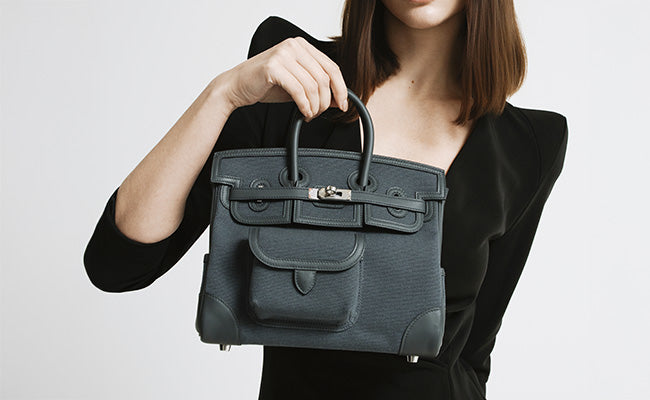
Twillies 101: Handle Protection that Also Boosts Resale
Check out our Hermès collection and Birkin bags!
Those elegant silk strips wrapped around Hermès bag handles aren't just a fashion statement, they're one of the smartest ways to protect your luxury handbag.
Twillies shield handles from oils, lotions, and everyday wear, and they might even help your bag keep its value by preserving the leather. A well-maintained Birkin fetches much higher prices than one with worn handles, so these silk accessories are more than just pretty ribbons.
We've all seen those gorgeous bags with dark, misshaped handles that scream heavy use. Handle wear is usually the first thing that shows up on our Hermès pieces, especially lighter leathers that seem to soak up every bit of oil from our hands.
While twillies add a pop of color and personality, it's really their protective job that makes them so valuable over time.
Twillies are versatile, you can swap out different designs to match your mood or outfit, all while keeping your investment safe.
From classic Hermès silk twillies to other soft fabrics, these wraps offer an elegant solution that blends style and practicality in a way only luxury fashion can.
Key Takeaways
- Twillies protect bag handles from oils and wear that can darken leather and lower resale value
- Switching out twillies lets handles breathe and keeps protection fresh
- The combo of style and protection makes twillies a must-have for anyone looking to preserve luxury bags
Why Twillies Matter for Bag Handle Protection
Bag handles get constant contact with our hands, which means oils, lotions, and dirt can easily damage expensive leather. Twillies act as a barrier, adding a little flair at the same time.
The Impact of Oils and Dirt on Handle Wear
Our hands naturally produce oils that transfer to bag handles every time we pick them up. These oils sink into the leather and create permanent dark marks that just won’t go away.
Hand lotions, perfumes, and sunscreen only make things worse. The mix of skin oils and beauty products breaks down leather over time.
Things that damage handles:
- Skin oils
- Hand creams and moisturizers
- Perfume residue
- Food particles
- Environmental pollutants
Twillies put a washable silk layer between our hands and the leather. When the scarf gets dirty, you can have it cleaned instead of watching your bag handles get ruined.
Birkin and Kelly bags, with their rolled leather handles, are especially at risk. Their smooth leather shows oil stains faster than textured leathers.
Material Preservation for Luxury Bags
Luxury bags use high-end leather that needs careful handling. Twillies help these materials last longer.
Handle wraps protect these leather types:
- Box calf (scratches easily)
- Togo (soaks up oils fast)
- Swift (shows marks quickly)
- Clemence (patina can get patchy)
Silk twillies stay cool, even in warm weather. This keeps sweaty hands off the leather, which helps prevent salt stains and extra wear.
Bags with wrapped handles often keep their original color and texture for years. Unwrapped handles, though, can darken within months if you use them regularly.
Switching out twillies gives handles a break and lets them breathe. This helps stop moisture from building up while you’re still getting protection when you carry the bag.
Preventing Discolouration and Denim Transfer
Dark denim is a real threat to light bag handles because of color transfer. Twillies protect expensive leather from this kind of permanent damage.
New jeans are especially risky during the first few wears. Extra dye rubs off easily onto bag handles.
When color transfer is most likely:
- Wearing new dark jeans
- Carrying bags next to leather jackets
- Contact with colored fabrics while traveling
- Exposure to wet clothing
Light bags, think Hermès Craie, Gold, or Etoupe, show color transfer right away. Once denim dye gets into the leather, fixing it is tough and costly.
Twillies catch any color transfer on the silk, not the leather. You can replace a stained twilly way more easily than restoring a handle.
Quality twillies have double-sided printing, so both sides resist color bleeding. That way, the scarf doesn’t end up staining your bag handles.
Boosting Resale Value with Twillies
Using twillies smartly protects your investment and can make a real difference in resale prices. Pristine handles fetch top dollar, while worn ones drag down what buyers will pay.
Condition and Value in the Luxury Resale Market
The luxury resale world is strict about condition. Hermès bags with protected handles often sell for 15-25% more than those with visible wear.
Authentication pros zoom in on handle condition. They check for:
- Darkening from oils and lotions
- Cracking in the leather
- Shape distortion from constant gripping
Twillies stop these problems when you use them right. Birkins with twilly-wrapped handles often keep their original color for years.
Bags that look barely handled always command higher prices. Twillies help make that happen without forcing you to baby your bag.
Minimizing Visible Wear and Tear
Handles take the most abuse. Every touch transfers oils, lotions, and dirt.
Common handle damage:
- Oil stains
- Color transfer from clothes
- Scratches from jewelry
- General darkening
Twillies block all of this. The silk takes the hit, not your leather.
Switching out scarves regularly helps, too. It stops indentations and keeps handles looking untouched.
We usually take twillies off once a month to let the handles breathe. It’s a simple habit that helps prevent color transfer and keeps protection at its best.
First Impressions for Potential Buyers
Buyers decide fast when they see listing photos. Clean handles show you took care of the bag and justify a higher price.
Resellers snap photos of handles from every angle. Any discoloration or wear pops out under bright lights.
Handles wrapped in twillies just look better in photos. They keep their texture and color, giving that “like new” vibe that gets people bidding.
It’s not just about looks, either. Buyers figure that if the handles are in great shape, the rest of the bag probably is, too.
Bags with perfect handles tend to sell faster and closer to asking price. The difference between protected and unprotected handles is huge when you’re reselling.
Style Meets Function: Expressing Personality Through Twillies
Twillies turn practical accessories into style statements, all while protecting your bag. The right colors and prints can totally change your bag’s personality and match your vibe.
Coordinating Twillies with Your Wardrobe
Ever stood in front of your closet, wondering how to make that Kelly work with your outfit? Twilly choice is your secret weapon.
Seasonal matching is great for pulling together a look. Burgundy and forest green twillies look amazing with autumn sweaters and coats. In summer, bright coral or turquoise prints pop against lighter clothes.
Think about your main colors when picking twillies. If you wear a lot of navy and cream, look for twillies with those shades.
Contrast can be stunning. A mostly black wardrobe wakes up with a bold orange or fuchsia twilly. Neutrals get a whole new look with jewel-toned accents.
For work, go subtle. Pick twillies with soft prints that echo your business wear without stealing the show.
Selecting Classic Versus Trendy Prints
Classic prints never go out of style. Equestrian themes, geometrics, and florals stay chic year after year. They hold their appeal and help with resale value.
We usually suggest starting with neutral classics before going for bold patterns. Cream backgrounds with navy details work with all sorts of bags and outfits.
Trendy prints are fun but can feel dated fast. Limited editions or seasonal designs are exciting, but might not age well.
If you’re investing, classics are the way to go. They work with more bags, so you get more wear. Trendy ones are best as a fun extra once you’ve got the basics.
Collectors often mix it up, maybe 70% classic, 30% trendy. That way, you get versatility and still show off your personality.
How to Wrap Twillies for Maximum Protection
Wrapping technique makes a big difference. If your twilly’s loose, it won’t protect much. The trick is to wrap tightly, overlap well, and secure the ends so they don’t shift.
Full-Handle Wrap Technique
The full-handle wrap covers the entire handle for max protection. Start with a tight knot at the base.
Spiral the twilly up the handle, overlapping each layer by half. This covers the leather and blocks oils, dirt, and scratches.
Keep the wrap snug as you go. Loose wraps move around and leave gaps. At the top, finish with another tight knot or tuck the end under.
If your handle has hardware, wrap carefully around it. The twilly should sit close to the metal without bunching or bulking up the bag’s shape.
Half-Handle and Bow Styles
Half-handle wraps focus on the spots you touch most and add a decorative touch. Center the twilly at the middle of the handle.
Wrap each end in opposite directions, crossing them in an X. This spreads out wear and keeps the twilly from slipping.
Tie the ends in a bow or knot wherever you like. A slightly off-center bow looks especially cute. Leave enough tail so the bow holds its shape.
This style looks great on more structured bags, where a full wrap might seem too casual. The bow adds a feminine touch while still protecting key areas.
Tips for Keeping Twillies Secure
Pick twillies with a bit of texture, they grip better than super-smooth ones.
Gently pre-stretch your twilly before wrapping. This gets rid of extra stretchiness that can make it loosen up during the day. Just pull it along its length with even pressure.
Double-knot at the ends. One knot, then another on top, keeps things from slipping as you use the bag.
Maintenance tips:
- Daily: Quick check to adjust if needed
- Weekly: Retie if it feels loose
- Monthly: Unwrap and redo for best protection
Store bags with twillies in dust bags so the silk doesn’t snag. If you’re putting bags away for a while, take the twillies off to avoid creasing both the scarf and the leather.
Care and Maintenance of Twillies and Handles
Keeping silk twillies and bag handles clean and fresh is key. Regular cleaning and rotation stops stains from setting and helps your accessories last.
Cleaning Silk and Fabric Twillies
For silk twillies, dry cleaning is safest. It keeps the colors bright and the fibers intact. Washing at home can shrink, bleed, or ruin the fabric.
For small spots, dab gently with a damp cloth and distilled water. Never rub or scrub, silk is delicate.
Quick cleaning tips:
- Blot spills right away, don’t wipe
- Use only white cloths to avoid color transfer
- Let them air dry fully before storing
Store clean twillies flat in acid-free tissue inside cotton pouches. Skip plastic bags, they trap moisture and can cause mildew.
Fabric twillies might handle gentle hand washing (check the label). Use cool water and silk detergent.
Rotating and Storing Handle Wraps
Take twillies off every couple of weeks to let the leather breathe and avoid indentations. Constant pressure can deform handles.
Rotation guide:
- Daily bags: Remove weekly
- Occasional bags: Remove monthly
- Stored bags: Remove twillies altogether
When storing, roll twillies loosely around tissue tubes to prevent creases. Keep colors separate so they don’t bleed onto each other.
Have a few twillies per bag and rotate them. This stops one pattern from wearing out and keeps your handles protected.
Store twillies in a drawer with dividers or individual pouches. Label them by color or pattern if you like easy access when styling your bags.
When to Use (or Skip) Twillies on Your Bags
Whether or not you use twillies really depends on your style and what you’re doing. Sometimes they’re perfect, sometimes not so much. It’s all about what feels right for you and your bag.
Personal Preferences and Fashion Statements
Some of us just like the classic, unadorned look of our Hermès bags. The clean lines of a Birkin or Kelly, honestly, they can do all the talking without any extras.
Twilly lovers appreciate them for:
- Adding a little coordinated colour to an otherwise monochrome outfit
- Switching up seasonal looks with new patterns
- Showing off some personality with Hermès' wild or artistic designs
- Building a signature style by sticking to certain twillies
Skip twillies when:
- Your bag already turns heads with bold leather
- You’re more into minimalist vibes
- The twilly colours just don’t work with your wardrobe
- You want to see that natural patina develop over time
It seems like newer Hermès fans often reach for twillies, while longtime collectors sometimes just let the bags shine on their own. Honestly, it’s all up to you.
Situational Tips: Summer, Travel, and More
Summer months practically beg for twillies. The silk stays cool and keeps sticky sunscreen or lotion off your handles when it’s hot.
Travel situations, yeah, twillies are a lifesaver. They guard against whatever your bag touches: airport bins, hotel counters, you name it. That extra layer helps keep your investment safe.
Skip twillies during:
- Fancy evening events where less really is more
- Rainy days (wet silk can stain)
- Times when you’ll be adjusting your bag a lot (twillies sometimes slip loose)
Professional settings, well, it depends. More conservative industries might prefer a bare handle, but creative fields? Go wild with colour and pattern.
If you’re thinking of reselling, maybe take off the twillies for photos. Buyers want a clear look at the handles.
Frequently Asked Questions
Twilly protection brings up a lot of questions about leather care, storage, and those little details that can make or break your bag’s resale value.
How can I ensure the leather on my investment stays pristine?
We wrap our handles with Hermès twillies or any slim, soft scarf to keep skin oils and lotions off the leather. This helps prevent that darkening you see, especially on lighter bags.
Rotating your bags gives each one a break. Don’t overload your Birkin. Too much weight can stretch and distort the handles for good.
A bit of light conditioning keeps the leather supple. Store your bags away from sunlight, heat, and humidity if you want them to stay looking sharp.
What's the secret to bumping up my bag's value before a resale?
Condition, condition, condition. Store-fresh Birkins can go for $35,000+, while worn ones drop to $5,000. Twillies are a must for keeping those handles flawless.
Hang onto any Hermès Spa service records. That paperwork shows buyers you’ve taken care of your bag.
Keep the Cadena lock in its own dustbag so it doesn’t scratch the leather. It’s a small thing, but collectors notice.
Are there any chic accessory must-haves for luxury bag care?
Twillies, obviously, they’re practical and look good. Hermès also makes silk and cotton bag inserts so your keys and wallet don’t leave marks inside.
Soft charms like the Hermès Rodeo or Pegasus add flair without damaging the leather. I’d avoid heavy or hard charms, they can leave dents.
Rubber caps on the feet add a bit more protection, though honestly, a few scuffs there are normal.
What's the best way to store these beauties when not in use?
We lightly stuff our bags with acid-free tissue or bubble wrap, then lay them flat with a small bolster under the handles. Keep everything in the original dustbag and box.
Make sure the felt protector is in place so the sangles don’t press into the pontets. Wrap the sangles around the spindle, but don’t thread them through the pontets.
Cool, dry storage is key. Humidity is the enemy, ventilation helps keep hardware from tarnishing.
Could you spill the tea on maintaining that just-out-of-the-box freshness?
Take off the twillies now and then so the handles can breathe, leaving them on all the time can trap moisture. I like to rotate my twillies regularly.
Those plastic hardware protectors spark debate. For long-term storage, they can trap humidity and cause tarnish. If you use your bag a lot, just take them off.
Prevention is way easier than fixing damage later. Use bag inserts religiously, Hermès Spa won’t refurbish the inside, so better safe than sorry.
Are DIY Hermès bag care solutions worth the hype, or should I leave it to the pros?
Basic protection, think twillies, careful storage, that's totally doable at home. Most of us can handle these simple steps without much fuss.
But when it comes to real restoration? Hermès Spa treatments use their own techniques and materials. DIY can't really compete there. Getting a pro cleaning and conditioning every so often keeps your bag looking its best for years.
Hang on to receipts from any professional work. They help if you ever decide to resell. Personally, I see major repairs as more of an investment than an expense, better safe than sorry, right?



